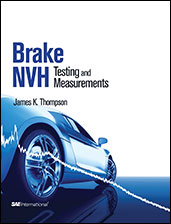Technical Paper
The Development of a Brake Insulator Damping Measurement Procedure
2010-10-10
2010-01-1685
The development and validation of a brake pad insulator damping measurement procedure by the SAE Brake NVH Standards Committee is described in this paper. The details of the test procedure, test set-up and recommendations for proper test practices are described. The description provides an excellent foundation for evaluating the damping properties of a shim over a range of frequencies and temperatures. To document the repeatability of the measurement process, a Gage R&R study was conducted. The results show that a high level of repeatability is achieved over a range of temperatures and damping properties. An example application is described to illustrate the usage of the procedure. This example provides an excellent illustration of how this procedure can be used to select the best shim for a specific application. Conclusions as to the applicability of this procedure and its value to brake noise control are provided in the final section.

